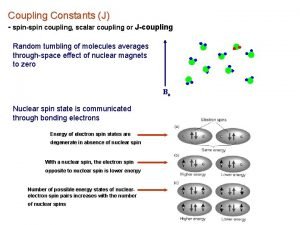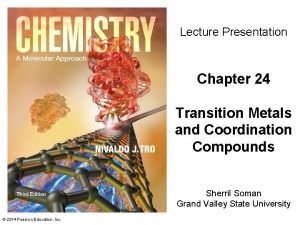Thermodynamics of Spin 3 ultracold atoms with free

- Slides: 1

Thermodynamics of Spin 3 ultra-cold atoms with free magnetization B. Pasquiou, G. Bismut (former Ph. D students), B. Laburthe-Tolra, E. Maréchal, P. Pedri, L. Vernac, O. Gorceix Université Paris 13, Laboratoire de Physique des Lasers, CNRS, UMR 7538, 93430 Villetaneuse France Chromium atoms have a large magnetic moment of 6 Bohr magneton : dipole-dipole interactions (DDIs) are much larger than in alkaline atoms. As a consequence, these strong DDIs offer the possibility to investigate the physics of a BEC with free magnetization. When the external magnetic field is lowered to the m. Gauss range, we observe a spontaneous demagnetization of the BEC : all Zeeman substates become populated. Our work is described in B. Pasquiou et al. , Phys. Rev. Lett. 106 , 255303 (2011) and Phys. Rev. Lett. 108 , 045307 (2012) Demagnetization of the BEC after a quench of the magnetic field Quantum phase diagram of the chromium BEC (S=3) at low magnetic field We suddenly reduce the value of the B field from 20 m. Gauss to a very low value. The field decreases with a 1/e time of 8 ms, set by Eddy currents. Contact interactions dominate, atoms interact through 4 molecular potentials, corresponding to S 2 body = 6, 4, 2 and 0 Measured : a 6 = 103 a. Bohr , a 4 = 64 a. Bohr deduced : a 2= -7 a. Bohr The BECspin composition at low field can be revealed by Stern-Gerlach analysis. The absorption pictures above have been taken after 150 ms of free evolution in the low B field, equal to a) 1 m. G; b). 5 mg c). 25 m. G and d) "0" m. G. unknown : a 0 As a 6 is not the smallest, the ground state is not anymore ferromagnetic at low B field Characteristics of the BEC: Natoms = 20000, µ = 4 k. Hz peak density = 3. 1014 cm-3 trap frequencies = 300, 400 and 550 Hz Value of the critical field Bc : We can do the same experiment with the BEC loaded in a 2 D optical lattices. ferromagnetic Characteristics of the 1 D quantum gases: - depth = 25 ER = 120 k. Hz >> µ = 11 k. Hz - peak density = 2. 1015 cm-3 - larger volume than the BEC (factor 3) for n = 3. 1014 cm-3, Bc = 0, 25 m. G Bc is reachable even in a non magnetic shielded environment ! nematic polar At "B =0", the spin populations are: {18+/-9, 18+/-4, 14+/-1. 5, 15+/-3, 17+/-3, 12. 5+/-4, 6+/-2} That is not the case with alkaline Example : Bc = 10 µG for Rb (a 2 -a 0 small) Depolarization as a function of the magnetic field Experimental stabilization of the B field When lowering the magnetic field below Bc, a quantum phase transition is expected Ref Diener et Ho, PRL 96, 190405 ; Santos et Pfau, PRL 96, 190404 In the lattice, the orientation of the B field plays no role, showing the effect of intersite coupling: the dipolar interaction Occurs at large interatomic distances Pasquiou et al, PRA 81 042716 Thermodynamics properties above Bc Single component Bose thermodynamics S=3 spinor gas: the non interacting picture Multi-component Bose thermodynamics AC noise = 500 µG, but is screened by the vacuum chamber DC fluctuations = 100 µ G on a one hour time scale A simple model to account for the depolarization dynamics: BEC: t <5 ms Dynamics of the demagnetization Tc 1(M) Evolution at fixed magnetization Results: We calculate the dynamics for the population transfer in m. S=-2 at short time, assuming P-2 << 1. The dynamics between the f-3 and f-2 components is then given by: Evolution for a free magnetization 1. 0 The 1/ e widths are compatible with (a) A 3 axis fluxgate sensor located at 15 cm of the chamber measures the B field for control An active compensation drive current in three pairs of large rectangular coils located at 1 m of the BEC ; the measurement of the residual B field fluctuations is made with an other sensor located at 20 cm from the first one The evolution is faster in the BEC case ! A phase (normal) 0. 8 A « bi-modal » spin distribution BEC in m. S= -3 0. 6 BEC in m. S=-3 0. 4 8000 BEC in each component 0 -1 population C phase 0. 2 Tc 2(M) -2 -3 Magnetization 1 D gases: t =15 ms For atoms loaded into an optical lattice, the large increase of the (repulsive) contact mean-field forces the cloud to swell. The overall volume of the cloud is then increased by a factor of about three, hence reducing the dipolar mean-field. A slower depolarization dynamics in the lattice is a consequence of the non local character of DDI, and indicates inter-site inelastic dipolar couplings in the lattice. B phase This gives G-1 = 3 ms and 10 ms for resp. the BEC and the 1 D quantum gases Dynamics for Bdd < Bc is under study 6000 4000 Thermodynamics properties below Bc 2000 -3 -2 Boltzmanian fit -1 0 1 2 m depolarized thermal gas Almost constant magnetization Reduction of the condensed fraction A new thermometry Experimental Results Only thermal gas depolarizes Cooling scheme if selective losses for m. S > -3 e. g. field gradient B = 0. 9 m. G > Bc B < Bc B >> Bc B < Bc Tspin more accurate at low T ! BEC in m=-3 thermal gas Tc 1 is the critical temperature for condensation of the spinor gas (in the m. S=-3 component) the kink in magnetization reveals BEC Solid line: results of theory without interactions and free magnetization for B < Bc, magnetization remains constant after the demagnetization process independent of T Summary of our results This reveals the non-ferromagnetic nature of the BEC below Bc -3 for T < Tc 2 BEC in all m. S ! Tc 2 B=Bc(Tc 2 ) Tc 1 for Tc 2 < Tc 1 BEC only in m. S = -3 -2 The good agreement shows that the system behaves as if there were no interactions -1 Stern Guerlach analysis of the depolarized gas (expected for S=1) Isoshima et al. , J. Phys. Soc. Jpn, 69, 12, 3864 (2000) The BEC is ferromagnetic: only atoms in m. S=-3 condense (i. e. in the absolute ground state of the system) evolution for B < Bc evolution for B > Bc Bc reached Due to contact interactions, below Bc we have a multicomponent BEC, with free magnetization due to DDIs, behaving almost like a noninteracting BEC with fixed magnetization Other results Other work: we use Bragg scattering to measure the excitation spectrum of the BEC * at "high B fields": due to DDIs, the speed of sound depends on the orientation of B with respect to the one of the momentum transfer - see the poster of Olivier Gorceix on Thursday * below Bc, we have just measured a dramatic change in the excitation spectrum at low q, in the lattice (preliminary results) Current work: resonant dipolar relaxation in 3 D optical lattices see the poster of Amodsen Chotia on Thursday All components remain Bose condensed Graduate students are welcome ! Work supported by : Conseil Régional Ile-de-France (Sesame contract), Ministère de l'Education Nationale et de la Recherche (CPER), European Union (Fonds Européen de Développement Régional) and IFRAF

